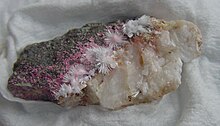Picropharmacolite
| Picropharmacolite | |
|---|---|
 Picropharmacolite with guerinite and erythrite from Bauhaus, Hesse, Germany. Specimen size 5.5 cm | |
| General | |
| Category | Arsenate mineral |
| Formula (repeating unit) | Ca4Mg(AsO3OH)2(AsO4)2·11H2O |
| IMA symbol | Ppm[1] |
| Strunz classification | 8.CH.15 |
| Dana classification | 39.2.4.1 |
| Crystal system | Triclinic |
| Crystal class | Pinacoidal (1) (same H-M symbol) |
| Space group | P1 |
| Unit cell | a = 13.547 Å, b = 13.5 Å, c = 6.71 Å; α = 99.85°, β = 96.41°, γ = 91.6°; Z = 2 |
| Identification | |
| Formula mass | 940.48 g/mol |
| Color | White or colorless |
| Crystal habit | As prismatic crystals more typically in radial aggregates, globular crusts, and fibrous concretions |
| Twinning | None reported |
| Cleavage | Perfect on {100} and {010} |
| Fracture | Micaceous |
| Tenacity | Fragile |
| Mohs scale hardness | 1 to 2 |
| Luster | Silky, slightly pearly |
| Streak | White |
| Diaphaneity | Translucent to opaque |
| Specific gravity | 2.58 - 2.60 |
| Optical properties | Biaxial (+) |
| Refractive index | nα = 1.631, nβ = 1.632, nγ = 1.640[2] or nα = 1.557, nβ = 1.566 – 1.571, nγ = 1.577 – 1.579[3] |
| Birefringence | δ = 0.009 |
| 2V angle | 40° - 50° |
| Dispersion | r < v strong |
| Other characteristics | Fluorescent blue-white under long wave and short wave ultraviolet light |
| References | [2][3][4][5] |
Picropharmacolite, Ca4Mg(AsO3OH)2(AsO4)2·11H2O, is a rare arsenate mineral. It was named in 1819 from the Greek for bitter, in allusion to its magnesium content, and its chemical similarity to pharmacolite. The mineral , Ca4Mg(AsO3OH)2(AsO4)2·4H2O, has the same composition as picropharmacolite, except that it has only four water molecules per formula unit, instead of eleven. It may be formed by the dehydration of picropharmacolite.
Structure[]
Infrared spectra[6] show that picropharmacolite contains water molecules H2O, hydroxyl groups (OH)− co-ordinated with Mg2+ cations, and acid arsenate radicals (HAsO4)2−. There are strong structural similarities with , Ca5(AsO3OH)2(AsO4)2.9H2O which indicates a similar formula for the two minerals.[7]
X-ray diffraction methods indicate that As, Ca and Mg cations are positioned in corrugated layers parallel to the c axis, the layers being linked by hydrogen bonding only. Four independent water molecules are sandwiched between adjacent layers, and build up hydrogen-bonded chains which are also parallel to the c axis. The ratio of four Ca to one Mg remains fairly steady, and no significant Ca/Mg substitution occurs in any cation site. Hence if the formula of picropharmacolite is written as Ca4Mg(H2O)7(AsO3OH)2(AsO4)2.4H2O,[8] it is a better representation of the structure than the more usual formula Ca4Mg(AsO3OH)2(AsO4)2.11H2O.
Morphology[]
Picropharmacolite is usually found as small to microscopic pearly white botryoidal aggregates with a radiating foliated structure internally. Less commonly it occurs as silky fibrous aggregates or minute needle-like crystals, that are rectangular prisms elongated along the c axis.
Environment[]
Formed as an oxidation product of arsenic-bearing sulfides in reaction with surrounding calcium-bearing rocks, and as a recent efflorescence in mine workings. Erythrite and pharmacolite are common associated minerals.[3]
Type locality[]
It was first described for samples from ore dumps of the Richelsdorf Smelter, Süss, Richelsdorf District, Hesse, Germany.[4] The type material is stored at the National School of Mines, Paris, France, 95.497.[3]
References[]
| Wikimedia Commons has media related to Picropharmacolite. |
- ^ Warr, L.N. (2021). "IMA–CNMNC approved mineral symbols". Mineralogical Magazine. 85: 291–320.
- ^ a b Gaines et al (1997) Dana's New Mineralogy Eighth Edition, Wiley
- ^ a b c d http://rruff.geo.arizona.edu/doclib/hom/picropharmacolite.pdf Handbook of Mineralogy
- ^ a b "Picropharmacolite".
- ^ "Picropharmacolite Mineral Data".
- ^ American Mineralogist (1974) 59:807
- ^ American Mineralogist (1976) 61:326
- ^ American Mineralogist (1981) 66:385
External links[]
- Arsenate minerals
- Triclinic minerals
- Minerals in space group 2